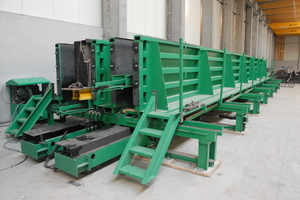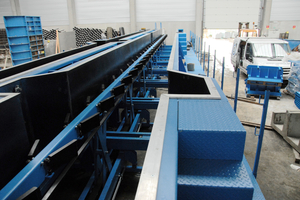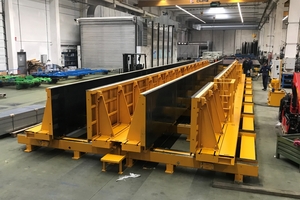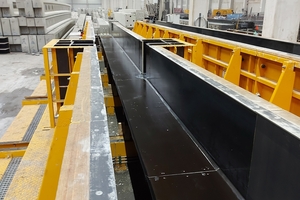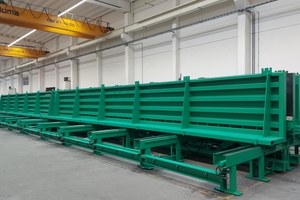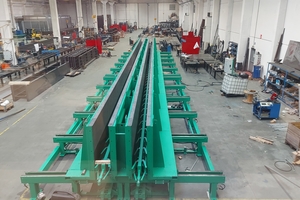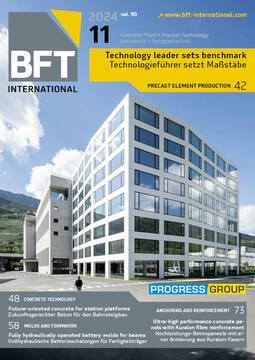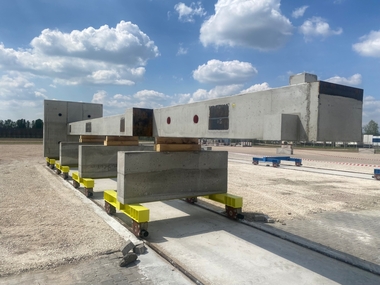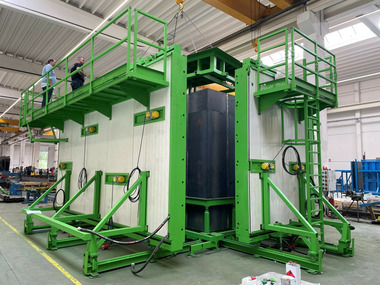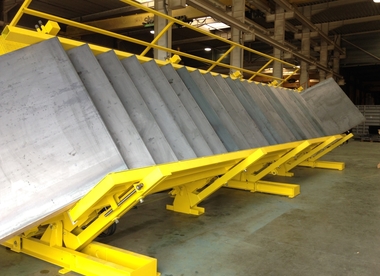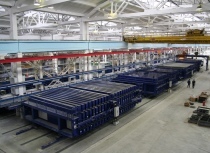Construx Weckenmann Bibat molds:
Fully hydraulically operated battery molds for precast concrete beams and columns
For many decades, Construx Weckenmann has been manufacturing state-of-the-art battery molds for precast reinforced concrete beams and columns. These molds may be manually adjustable and simple to use or operated fully hydraulically. Construx Weckenmann has a suitable solution for every application, for precast factories as well as for on-site use. Bibat molds are designed for large-scale precast facilities, where manual labor must be reduced as much as possible.
Bibat: Fully hydraulically operated battery mold
A standard Bibat configuration consists of a fixed center panel and two movable panels, all of which with an 8 mm steel sheeting. The panels are opened, closed and secured by means of hydraulic cylinders, hence without any manual intervention. It is also possible to install additional intermediate panels in-between the movable panels and the fixed center panel. In this case, the additional panels will have to be locked into position by using tie bars.
Customers are free to choose any panel length or height. Lengths from 10 to 25 m and multiples (combinations) are very common. The stroke length of the cylinders combined with the height of the panels determines the maximum and minimum dimensions of the elements that can be produced in a Bibat battery mold. Anything between 600 and 1,200 mm is considered to be a standard maximum height. To create a safe and ergonomic work environment, all Bibat molds have full-steel working platforms with access steps and handrails.
Several options are available to complete the range of Bibat battery molds:
Fixed or modular panels; modular panels are removable and interchangeable
Box-outs to cast corbels together with the columns
Hydraulically adjustable supports to set both the lateral position and the height and width of the soffits
Various manual systems for adjusting the soffit height
Fixed or removable triangular chamfers or integrated timber planks at the top of the panels
Working platforms with access stairs and handrails at different levels
Full-steel soffits with chamfers and rubber seals
Construx Weckenmann 18 m long Bibat mold at Betca (Belgium)
This Bibat mold has two 18 m long pockets, with panels that can be rolled manually in the longitudinal direction of the pockets and removed with the overhead crane. These modular panels are secured with triangular braces and held together with round-threaded, self-centering conical bolts and nuts. Where required, a panel can be removed and replaced by a corbel box-out. The modular panels have various lengths (3,000, 2,500, 2,000, 1,000 and 500 mm), which makes the mold very flexible for manufacturing columns with corbels at multiple positions. The cylinders have a 1,200 mm stroke, from 280 to 1,480 mm, which allows for a casting width from 300 to more than 1,000 mm. When using 218 mm high soffits, made from timber H-20 beams and 18 mm plywood, the maximum net casting height is 1,000 mm. Adjusting the height of the soffits is done by means of a manual propping system.
Construx Weckenmann 25 m long Bibat mold at Cobatim (Belgium)
This Bibat mold has two 25 m long pockets, with fixed panels. The cylinders have a 1,200 mm stroke, from 390 to 1,590 mm, which allows to cast 700 mm wide columns with 300 mm wide corbels on either side, or even 1,300 mm wide beams. The fully hydraulically controlled height adjustment system can be moved sideways and up and down. It also has wings that can open and close for supporting soffits with a width from 400 to 1,000 mm. When using 150 mm thick steel soffits on top of the hydraulic adjustment system, the net pouring height may vary from 600 to 1,200 mm. This massive and extremely performant Bibat battery mold allows for a maximum load of 1,500 kg/m2 with the hydraulic height adjustment system at its lowest position. Full-steel working platforms with access stairs and handrails make this mold a safe and secure precast machine.
Shaping the Future of Concrete
Construx Weckenmann meets the requirements of every customer to obtain the most appropriate solution for manufacturing their precast elements. The outcome of achieving such an objective is always a very satisfied customer.
In addition to precast molds, Construx Weckenmann develops and produces custom-built formwork for infrastructure projects, together with a complete range of modular shuttering and scaffolding systems. This versatile approach proves that Construx Weckenmann is a technically driven production company that relies on the commitment, creativity, and experience of its employees. Their aim is to establish a partnership, rather than to be a supplier, in providing turnkey solutions for precast and on-site formwork issues. Their mission, “Shaping the Future of Concrete”, is the best definition of what Construx Weckenmann stands for.

